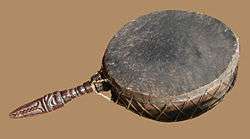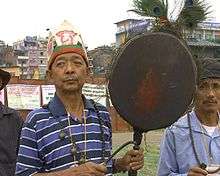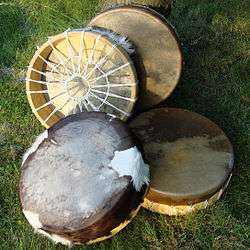Dhyāngro
The dhyāngro is a frame drum played by the jhakri (shamans) of Nepal—especially those of the Magars, the Kirati, and the Tamang—as well as by Tibetan Buddhist musicians.
 | |
| Percussion instrument | |
|---|---|
| Classification | Frame drum |
| Hornbostel–Sachs classification | 211.32 (Directly struck membranophone) |
The dhyāngro may be either single- or double-headed. Double-headed drums are said to have a male side and a female side.[1] The drumhead, which is made from animal skin, is struck with a curved beater fashioned from cane.[2] The frame may also be equipped with jingles. Like the na drum of Tibet, but unlike most frame drums, the dhyāngro usually has a handle. The carving in the wooden handle of a dhyāngro may be quite intricate; owing to Buddhist influence, the handles of some drums are fashioned into a kīla.
Ceremonial use
In Nepal, a jhakri (shaman) plays the dhyāngro during traditional shamanic ceremonies.[1]
The drum is occasionally used in Tibetan Buddhist celebrations, as in an orchestra performing Buddhist music. For example: In Malaysia, such a performance greeted the seventh Ling Rinpoche when he visited the Tadika Than Hsiang Farlim and Child Care Centre on Penang Island.[3]
References
- Bhola nath Banstola (2008). Breeze Wood, Nicholas (ed.). "Jhankri: The Shamans of Nepal" (PDF). Sacred Hoop (60). ISSN 1364-2219. Retrieved 12 August 2013.
- "Images from the Beede Gallery: Frame Drum (Dhyāngro), Nepal, Early 20th Century". National Music Museum. University of South Dakota. 2010. Retrieved 12 August 2013.
- "Visit by His Eminence the 7th Ling Rinpoche". Than Hsiang Temple. 31 December 2009. Retrieved 12 August 2013.

